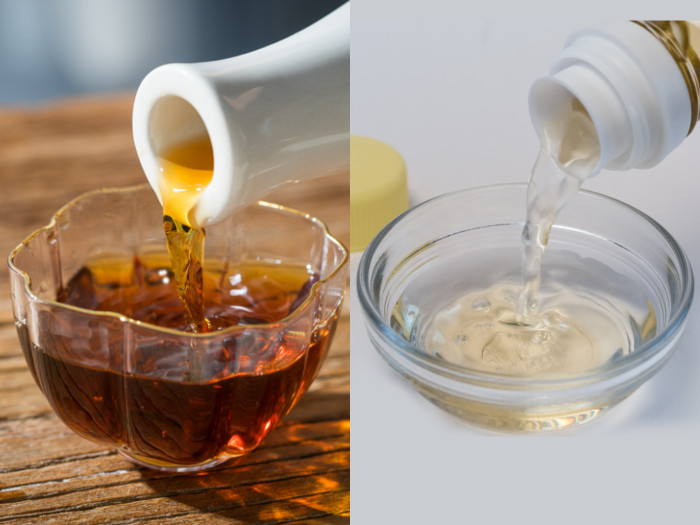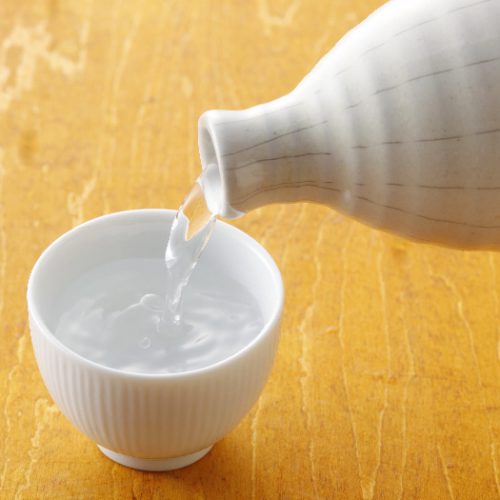There always seems to be confusion about rice wine vs. rice vinegar, but the difference between these two is quite simple. While both are delicious and useful, it is important to know what makes them unique before using them in the kitchen!
Difference between Rice Wine vs Rice Vinegar
By definition, rice wine is a type of wine that is made from fermented glutinous rice, unlike other wines, which are normally made from fermented fruit. Rice wine is popular in many Asian cuisines, both as a beverage and as an ingredient in cooking. Regardless of how you choose to use rice wine, it tends to impart a sweet flavor. The most popular types of rice wine include sake (Japan) and Shaoxing (China). Remember that rice wine is made only by allowing the rice to ferment into alcohol, resulting in a relatively low-alcohol content beverage or cooking ingredient. [1]

Rice wine is mostly consumed as a beverage whereas the vinegar is used in cooking. Photo Credit: Shutterstock
Rice vinegar, on the other hand, is made through a very similar process – the fermentation of glutinous rice. However, while rice wine producers stop the process when alcohol has been produced, rice vinegar is produced when the alcohol is allowed to further ferment into acetic acid. This gives rice vinegar its highly acidic bite, which is why it is often used in different culinary applications. The most common form of vinegar is common white vinegar, which has a highly astringent taste and is rarely used in cooking. [2]
Rice vinegar is not consumed as a beverage, but it does have a rather mild, delicate flavor that borders on the edge between sweet and sour. Rice vinegar is commonly used in sushi rice, marinades, and salad dressings.
How to Make Rice Wine & Rice Wine Vinegar?
You can make both, rice wine and rice wine vinegar, at home. Let us look at the recipes.
Rice Wine Using An Oven
Here we have made rice wine using an over. If you don’t want to use an oven, visit Rice Wine Benefits, Recipe & Side Effects for a simpler recipe.

Rice Wine Vinegar Oven
Ingredients
- 2 cups sticky rice
- 3 cups water
- 1 yeast ball (known as jiuqu)
Instructions
- Rinse the rice with water and then cook in the water.
- Spread the cooked rice to cool on a baking sheet.
- Crumble the yeast ball and sprinkle on the warm rice.
- Add the rice and yeast to an airtight container and place in the oven on low (100-110 degrees Fahrenheit)
- After 2-3 days, the wine will begin to gather at the bottom of the bowl.
- Allow fermentation to continue for another 2-3 days, then strain out the wine and store for use.
- You can let the rice ferment for a month. The liquid will get clearer and less clouded with time.
How to Make Rice Vinegar?
Follow this step-by-step method to make rice wine vinegar at home.

Rice Wine Vinegar
Ingredients
- 2 cups cooked sticky rice with cooking water
- 1 litre filtered water
- 2 oz rice wine
Instructions
- Place the rice in an airtight container along with its cooking water. Opt for stoneware or dark-colored glass jar as it aids fermentation.
- Add the rice wine vinegar to the rice and water.
- Add the water. Make sure it's filtered and not tap water. You don't want any added impurities and bacteria.
- Cover the jar with a cheesecloth. It will allow air circulation while keeping out the flies. You can put a couple of layers and fasten them with a rubber band.
- Place the container in a cool and dark place and allow it to ferment for 4 weeks.
- Keep checking on the fermentation process from the 3rd week onwards. You are looking for a sharp, acidic smell. Once you get that, taste it. It should taste tart like a vinegar.
- The taste the vinegar will keep changing the longer you ferment. The tart taste will also mellow with time.
- Once you have the right flavor, strain out the rice vinegar and store it for use. Fresh vinegar should be stored in a fridge. For keeping it at room temperature, you need to pasteurize it.
